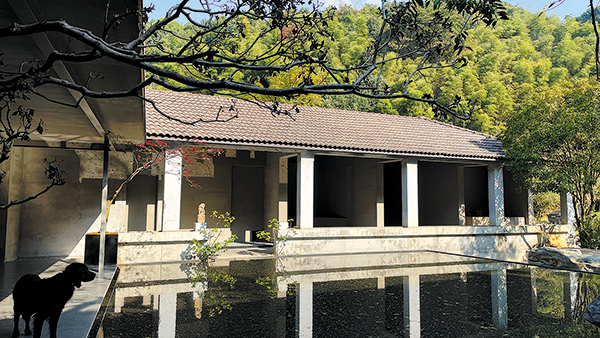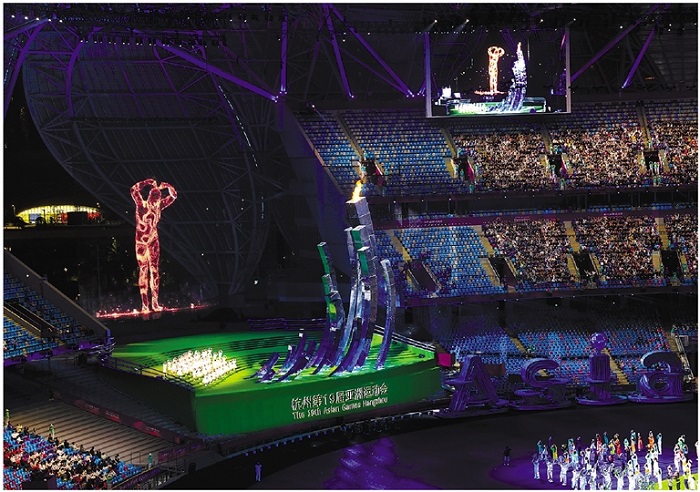Call of the wild

Shan Shan Garden, located in the outskirts of Hangzhou, Zhejiang province, boasts stunning views of mountains and forests. Four designers spent years transforming it from a wasteland into an inviting garden retreat.[Photo provided to China Daily]
In Hangzhou's Xihu district, nestled among the mountains, lies a unique garden. This site, once an abandoned mine spanning about 10,000 square meters, was discovered in 2019 by landscape designers Yu Weizeng and Chai Rong. Captivated by its potential, they, along with two partners, decided to lease the area and transform it into a garden studio.
Yu and Chai share a deep passion for nature, a longing for the beauty of mountains and water, and a love for life itself.
Their vision was not merely to create a functional workspace. Instead, they aspired to establish a vast courtyard within the mountains, crafting a garden that embodies the essence of the natural landscape.
"On fine days, we set up tents outside for camping together with friends. Gathering around a huge rock, we enjoy simple pleasures such as drinking coffee and playing the guitar. On rainy days, the sound of raindrops pattering against the surface of the pool creates a serene ambience. During full moon nights, we lie on the rocks, basking in the moonlight," Yu says.
Before the birth of this sanctuary in the mountains, called Shan Shan Garden — shan means mountain in Chinese — the team had already invested a year of hard work and dedication into creating a beautiful garden on another site. However, due to regulatory changes, their initial creation was dismantled.
According to Yu, searching for a new site, the team embarked on an exhaustive exploration of Hangzhou's outskirts.
Their persistence paid off when they stumbled upon a neglected site with over 500 square meters of built-up area. However, it was not in a perfect condition.
From wasteland to sanctuary
Originally a mine, the area had fallen into disuse and was being used as a dump for construction waste. It was covered with a thick layer of garbage, rendering it nearly inaccessible. The buildings on the site were in a state of severe disrepair, surrounded by wild grass and wasteland.
The location was identified as a geological hazard zone. During rainy seasons, a significant amount of water would run down the mountain, flooding the area and spilling onto the roads. This made the site virtually inaccessible during such times and even posed a risk of landslides.
This forlorn site, despite its initial bleakness, held the potential the designers were seeking. They realized it was a diamond in the rough waiting to be polished into their envisioned garden sanctuary.
Yu recalls the moment they first drove up to the site, describing it as an instant when everyone's eyes lit up with excitement. They were greeted by a majestic cliff face dominating the view. A long water pipe ran through the valley, striking a chord with its imposing presence, all set against the backdrop of the surrounding forests.
In a fortunate twist of fate, they discovered that the construction debris from their previous studio, which had been dismantled, was lying in this wasteland.
This revelation added an emotional dimension to their project. It was as if their past efforts had led them to this very spot, presenting them with an opportunity to reclaim and transform what they had lost into something even more magnificent.
The team engaged in an intensive period of observation and exploration. They tirelessly traversed the nearby hills and ridges from dawn to dusk. Their focus was not only on the land itself, but also on understanding the natural cycles and rhythms of the environment.
They observed the changing patterns of sunlight over a year, seeking to understand the nuances of nature's processes.
The transformation of the site meant starting from scratch, clearing and rebuilding from the ground up.
The initial step involved removing the accumulated construction debris, wild grass and overgrown vegetation. They painstakingly cleared up to 4,000 cubic meters of waste. Then, several thousand cubic meters of planting soil was brought in from outside. This extensive soil transportation and landscaping continued until 2022, laying the groundwork for the garden's creation.
In addressing the potential challenges of floods and garden maintenance, Yu and Chai ingeniously created a break in the mountainside, utilizing the natural elevation difference to construct a drainage system. This system serves a dual purpose. In dry conditions, it acts as a dry creek bed, adding an aesthetic landscape feature to the garden. However, during heavy rains, it transforms into an efficient flood channel, directing the water along a predetermined path into the city's drainage system.
By reshaping the landscape, the designers not only transformed the area's aesthetics but also enhanced its safety, turning a once-dangerous site into a secure and inviting garden retreat.
Closer ties with nature
While explaining their architectural philosophy, Yu says: "We integrated the buildings into the forests in such a way that they seem to dissolve into the surroundings."
A key feature in the garden is a reflective water pool set in the main space. As the sun sets, its rays bathe the cliff in a kaleidoscope of colors, with the mountain's reflection mirrored in the pool.
"We aimed to bring nature even closer," Yu says.
This intent is evident in their bold decision to incorporate a large natural rock into the indoor space. Recalling the challenging process, Yu mentions that it took seven or eight people wielding crowbars and coordinating their efforts to move the rock to the desired spot.
In a secluded corner of the garden, there's a narrow entrance leading to a space where a thin vertical window has been artfully placed. Outside the window, a red maple tree has been planted, offering a picturesque view reminiscent of an ancient scroll painting.
Yu elaborates on the significance of windows in their design. "Windows are the eyes of a building. Good spaces are often created around windows. With a window comes light, and with light, a view."
Walking along the stone pathway, visitors come across a hidden door leading to a tearoom. A striking feature of this room is a window approximately 7 meters long, framing the mountain landscape opposite.
Yu says that through this project, they also hoped to reflect the changing relationship between humans and nature.
"In the past, people lived in harmony with the natural world. They could step outside to see mountains and cross rivers. However, the rapid pace of urbanization has disrupted this connection," he says.
The issues of landslides and flooding, as encountered on their site, are stark reminders of the consequences of human activities disrupting natural systems.
Therefore, when they began work on Shan Shan Garden, their primary goal was environmental restoration. They aimed to reverse some damage caused by human intervention and restore a balance with nature.
"Our approach involves utilizing our technical expertise to solve certain issues, and then allowing nature to take its course," Yu says.
-
Asian Games brings about great changes to Hangzhou
December 25, 2023
-
Hangzhou Airport set to rejoin the ranks of world's busiest airports
December 14, 2023
-
Hangzhou named 'China's most livable city' for 2023
November 27, 2023
-
BRI 10 YEARS ON: Road to prosperity
October 16, 2023



